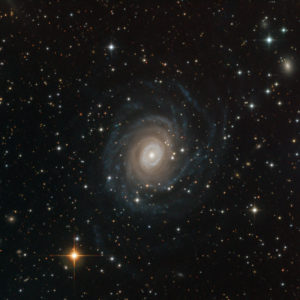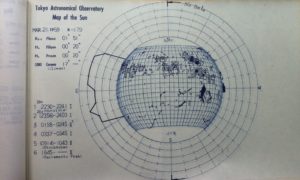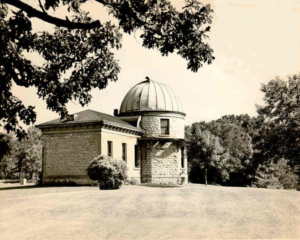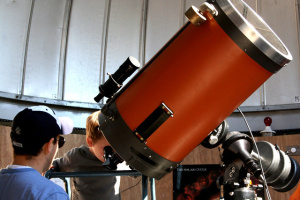Attleboro, Massachusetts, June 10, 2021, 5:30 a.m.-6:31 a.m. EDT
8×32 Lunt Sunoculars, 6×30 Lunt Sunoculars, welder’s glass, eclipse glasses



Attleboro, Massachusetts, June 10, 2021, 5:30 a.m.-6:31 a.m. EDT
8×32 Lunt Sunoculars, 6×30 Lunt Sunoculars, welder’s glass, eclipse glasses




The SPECULOOS Southern Observatory saw first light in December 2017. Located at ESO’s Paranal Observatory in Chile, SPECULOOS is designed to hunt for exoplanets around small, cool stars.
This image of NGC 6902, a galaxy about 120 million light-years from Earth in the direction of Sagittarius, was taken to test one of the four 1-meter telescopes that comprise SPECULOOS.
Visit the ESO site to download high-res versions of this image.
Messier 75 is a lot less dazzling through the telescope. Although I can nearly always detect a brightening at the core, it takes more than a 10-inch scope to resolve individual stars (I’m not sure I’ve ever resolved any). Still, M75 is a fun target. It’s a noticeably non-stellar patch of circular fuzz.
Click through the image to download a screen-size .jpg or publication quality .tiffs.

Tokyo Astronomical Observatory Map of the Sun, March 21, 1959. Image: Kodaikanal Observatory Library / JR
I found a whole book of these maps of the Sun made for the International Geophysical Year (July 1, 2957 to December 31, 29158) in the library at Kodaikanal Observatory. It took me awhile to track down their origin, but I finally found the entire collection online at the Solar Science Observatory of the National Astronomical Observatory, Japan. (Scroll down to the section of the table that says “Map of the Sun in the IGY period),
According to the Historical Sunspot Drawing Resource Page:
According to the National Observatory of Astronomy Japan (NOAJ), the dome housing the 20-cm refractor built in 1921 by Mr. Chodayu Nishiura. The refractor, set on an equatorial mount with clock drive, was used to map sunspots from 1938 to 1999.
Digging through notes I made during my research in the Lick Observatory archives in 2013, I found an intriguing letter written by Thomas Fraser, the foreman during the construction of the observatory, addressed to Richard Floyd, the chairman of the Lick Trust. Fraser wrote it while traveling in the spring and early summer of 1885, when he represented the observatory’s interests before various dignitaries and astronomers and studied extant dome designs in various eastern U.S. cities.
Fraser’s trip would be the envy of any amateur astronomer now. In New Orleans, he visited “the Exposition” (the World Cotton Centennial, which ran from December 1884 to June 1885 on the current site of the Audubon Park and Zoo) before moving on to Washington, D.C. via Mobile, Savannah, and Charleston. In D.C., Fraser enjoyed Grover Cleveland’s (first) inauguration and visited the Smithsonian Institute before visiting Fauth & Co., where he examined a “dividing engine for circles” and a 6-inch refractor that “beats Warner and Swaisey [sic] all to peaces [sic].” (Spelling, grammar, and punctuation were definitely not Fraser’s strong suits.)

Title page of Fauth & Co. catalogue, 1883, full text available at archive.org.
From D.C., Fraser traveled with Edward Holden (then President of the University of California, soon to be director of the Lick Observatory) to Charlottesville, VA, where they were met by Ormond Stone, director of the Leander McCormick Observatory at UVa. Fraser wasn’t much impressed with the observatory’s dome, writing that “There is many good points about this Dome for this place, but for our place this is many bad ones which must be remedied before we could adopted such a style of Dome … ” Fraser didn’t like the rigidity of the ring designed by the Warner & Swasey Company, nor did he think the gear for rotating the dome was sufficient to really get the job done. He did, however, like the shutters, even though “they are far from rain and snow proof.”
From Virginia, Fraser traveled to Boston via New York, where he tried but apparently failed to meet with Henry Draper. In the Boston area, Fraser first visited Alvan Clark’s workshop in Cambridgeport, MA (about 2-1/2 miles from where I’m sitting; the Central Square Branch of the Cambridge Public Library now sits on that site) to look at the 30-inch refractor Clark was building for Pulkovo Observatory. He then visited Charles Pickering at the Harvard College Observatory.
Fraser was busy in Boston (but not too busy to take a vacation in Lisbon, Maine, with his wife), wooing potential donors (James Francis up in Lowell), trying to sort out (by letter) issues with the lenses being constructed by Charles Feil in Paris, and so on. It took him awhile to move on. When he did, he stopped in New York and New Jersey to look at Princeton’s dome before heading to the United States Military Academy at West Point, NY, to study the dome at that school’s new observatory. What was special about this dome? It was made of paper.
West Point was only one of several U.S. observatories with paper domes at the end of the 19th century. I can see the allure of paper as a building material, at least in theory. It was lightweight, for one, and if you’ve ever played with papier-mâché, you’ll have some idea as to how it would work in a mold. It’s durability was already being tested in other areas of construction. Paper boats really were a thing back then, specifically, boats made by George and Elisha Waters (E. Waters & Sons) in upstate New York. It doesn’t seem like too much of a creative leap, anyway, to think about paper if you’re searching for a thin, durable, dome skin. The Annual Report of the Commissioner of Patents for 1881 indicates that E., C.W., and G.A. Waters filed a patent for paper domes on May 3rd. But were paper domes any good, or did Fraser find they, too, had “many bad points”?

“Paper Domes for Observatories,” The Printers’ Circular and Stationers’ and Publishers’ Gazette Vol. 18, 1883.
The first paper dome manufactured by E. Waters & Sons went to the Williams Proudfit Observatory at Rensselaer Polytechnic Institute in the Waters’ hometown of Troy, NY. Although the manufacturing process was kept a trade secret, the basics were reported fairly widely. The dome hemisphere was divided into sections and built out of molded wood ribs. The ribs were covered with linen paper molded to the right shape and treated with a (secret formula) resin. The individual wood-and-paper sections were then bolted together to form the dome. Allegedly RPI’s dome, which rotated on oversized ball-bearings on an iron track, worked just fine.
Given its proximity to RPI, it’s not surprising that the United States Military Academy (West Point) also ended up with a paper dome at its new observatory. West Point’s original observatory was part of the “old” Cadet Library, built in 1841.

William H. C. Bartlett, “Account of the Observatory and Instruments of the United States Military Academy at West Point; With Observations on the Comet of 1843,” Transactions of the American Philosophical Society
Vol. 9, No. 2 (1845), pp. 191-203.
This library observatory was described well in “Observatories of the United States,” published in Harper’s New Monthly Magazine for March 1874 (West Point is covered on pages 539-541). The same article announced that the observatory was in peril, for the West Shore Railroad Company had purchased the right of way to build a tunnel directly beneath the observatory property, necessitating the moving of equipment (the 12-inch Clark refractor, specifically) to a new site. The new site turned out to be a knoll on the east shore of Lusk Reservoir.

Landscape program proposed by Olmsted Brothers, from Sylvester Baxter, “The New West Point,” Century Illustrated Monthly Vol. 69, no. 3 (July 1904), p. 338.
I’m surprised how little has been written about the “new” West Point observatory, particularly since Holden ended up there as a librarian — or maybe that’s the reason. After Holden’s acrimonious departure from Lick in 1897, he more or less abandoned astronomy, taking up a librarian position at West Point in 1901. Or possibly it’s because the heavy-lifting was done by the U.S. Naval Observatory, not at West Point. At any rate, images of the observatory are difficult to find. A report on the observatory published in the Publications of the Astronomical Society of the Pacific in 1891 describes the instruments, but not the building. I found a campus map in the West Point archives that shows a cruciform floor plan, as well a photo-engraving that shows the exterior of the building.

Observatory footprint (3) from West Point yearbook, the Howitzer. Image: West Point Archives, U410.N5.H84 1946.

From Aldolph Whitman, U.S. Military Academy, West Point, N.Y.: photo-gravures, 1896. Archives identifier U410.L3 W783 1896.

Detail from Aldolph Whitman, U.S. Military Academy, West Point, N.Y.: photo-gravures, 1896. Image: West Point Archives, U410.L3 W783 1896.
It’s difficult to tell anything from that image, but that should be the paper dome, since the photo was taken only 13 years after the observatory was built. Was that paper dome great? Fraser didn’t seem to think so. This quote comes from the letter he wrote to Floyd, dated April 28, 1885, just two years after the observatory was built. The passage is a bit long, but interesting (if only for the spelling):
“I have been at West Point today to see the 30 foot Paper Dome covering a Clarks 12″ Objective I am free to say that Paper Covering for Domes is a failure in the full sense of the word the paper althou almost new is now cracked in lots of places and has pealed of in other places the paper was never pressed to the shape of the Dome but is a flat surface between the wooden ribs the shutter is hung inside of the Dome on a centre pivot at the top and swings round on a track or rail inside the dome it leakes and works bad the live ring is all rong and works with a watch takel and is awful hard they had a rope to revolve it but it worked so bad they toke it off [1v] you can’t reach the end of the tube frome the floor as the floor is too low they have a great big chair that costs heaps of money to make revolve around the pier on rails, they have a transit circle roome for a 7 ½” or 8” Repsolds Circle the Roome is not larger than our Transit House about 15×20 inside with 3 feet sonte walls and small windows there ventilation will be simpley horiable I should think money has been badely wasted here just the same as all the Observatorys I have seen ours beats them all to peaces there instrument the 12” and its mounting is rusty just like all the rest I expected better of the West Point boys I wonder will Prof Holden have his in good order if not we better never turn our Observatory over to an astronomer from what I have seen of them”
Ouch. Fraser expected better of the West Point boys, and judging from his evaluation, I would’ve expected the dome to fail a week or two later. Of course, it didn’t, and we know Fraser was a bit … hard to please … when it came to domes, so it probably wasn’t the disaster he described. Although the dome was repaired at one point in its long life, it was never replaced.
According to Jim Chung (Astro-Imaging Projects for Amateur Astronomers: A Maker’s Guide, Springer 2002), the observatory and refractor were restored in 1938 by a sophomore cadet named Alan Edward Gee, but after Gee graduated, no one used the observatory. I dug deep into the S&T archives and found a mention of a visit to the West Point Observatory made by members of the Amateur Astronomers League of America (A.A.A.) in May 1941 (“Notes on the A.A.V.S.O. Spring Meeting,” The Sky Vol. V, No. 9 (July 1941): 16). The group operated the “fine 12-inch refractor which is unfortunately not used at the present time” during their visit, as well as the dome, though no one described the dome in print. The author of an article on paper canoes in the February 1951 issue of Popular Science claimed that the West Point dome was “still good as new.” However, a 2004 historic structures report on the redoubts of West Point noted that the observatory was demolished in the 1950s, so it seems unlikely that the dome was in pristine condition at that late a date.
At least two other college observatories sported paper domes: Beloit College and Columbia. Beloit’s Smith Observatory welcomed its paper dome on September 6, 1882. The dome apparently stood until the observatory building was demolished in 1969.

Smith Observatory
Image: Beloit College Archives
The dome for the new observatory at Columbia (then College, now University) necessarily needed to be lightweight. The observatory was built on top of the college library, 110 feet above grade, on iron girders “entirely independent of the floor.” According to the Printers’ Circular reproduced above, Columbia’s dome was 20 feet in diameter and 11 feet tall, “yet so light that it [could] readily be turned with one hand.” That would certainly be handy. But a historical sketch of Columbia, written in 1893, noted that “the position of the observatory in the middle of a city block close by one of hte largest railroads in the country, and surrounded by smoky chimneys and brilliant electric lights, makes it a poor place generally for observation.” Plans were already in the works for a new observatory at 116th Street. So the longevity of the paper dome was probably the least of the university’s worries.
Did the paper dome “craze” last? Not in a professional context. Certainly it wasn’t practical for the large-scale domes like the one at Lick (interested parties can send me their calculations for live loads on a paper observatory roof — could it hold the snow?). But I recently came across this thread on Cloudy Nights, and it seems the paper dome still has a place in amateur astronomy.
 NEFAF is back! The New England Fall Astronomy Festival is this weekend, September 9 & 10 (Friday and Saturday) at the Durham campus of University of New Hampshire. This year’s special guest and keynote speaker is Dr. Seth Shostak (SETI). He’ll be talking to students and faculty on Friday, September 9th at 1:00 PM in the Strafford Room on the UNH-Durham campus and also giving the Keynote Address from 7:00-8:15 p.m. at the Main Tent at UNH Observatory.
NEFAF is back! The New England Fall Astronomy Festival is this weekend, September 9 & 10 (Friday and Saturday) at the Durham campus of University of New Hampshire. This year’s special guest and keynote speaker is Dr. Seth Shostak (SETI). He’ll be talking to students and faculty on Friday, September 9th at 1:00 PM in the Strafford Room on the UNH-Durham campus and also giving the Keynote Address from 7:00-8:15 p.m. at the Main Tent at UNH Observatory.
There are tons of activities on the schedule for kids (building rockets!) this weekend, in addition to lectures from notable amateur and professional astronomers aimed at the adults in the crowd. Don’t miss the Saturday afternoon discussion panel with John Gianforte (The Sky Guy), Dr. David Kipping, Dr. Seth Shostak, Dr. Suzanne Young, and Dr. Harlan Spence. And stick around: S&T‘s Kelly Beatty will be talking about the 2017 total solar eclipse.
On Friday night, Joel Harris will give a tour of the night sky for novice observers. Marc Stowbridge will be giving the Saturday night sky tour. I’ve been looking at the sky my entire life, and I still haven’t gotten tired of listening to/watching sky tours. The UNH Observatory will be open, so this is your chance to look through a 14-inch telescope.
I’m reprinting the full NEFAF schedule here, but you should check out the NEFAF facebook page for more details.
NEFAF Program Listing for Friday, September 9
NEFAF Program Listing for Saturday, Sept 10, 2016
11-5:30 PM INFORMAL SCIENCE TALKS BEGIN – Speaker’s Tent
EXHIBITORS IN THE MAIN TENT 10:00AM – 4:00 PM
A few iPhone photos taken through the Celestron 130-mm reflector during the total lunar eclipse on September 27, 2015. Taken from the Mill Pond parking lot in Maynard, MA. No editing.
Making the best of being stuck in a plane.

NH Observatory Manager Ian Cohen safely shows a young observer the Sun through the Observatory’s main telescope, a 14-inch reflector. Credit: Loni Anderson/NEFAF
Here’s hoping clear skies will come our way this month. First, there’s the total lunar eclipse to watch in the early a.m. hours of October 8 (evening hours of October 8 if you’re reading this from Australia). That’s super exciting, so it’s probably destined to coincide with cloudy weather.
But I’m also looking forward to the New England Fall Astronomy Festival later this month. Events will take place on the west end of the University of New Hampshire Campus (Durham) at the UNH Observatory. The weekend kicks off on Friday, October 17, with a 6 p.m. lecture by Carolyn Porco, Imaging Science Team Leader for the Cassini-Huygens Mission to Saturn. After the lecture and a Q&A session, clear skies will bring a chance to look through some great telescopes and listen to some star talks. The festival continues on Saturday (10 a.m. to midnight), with more observing sessions, activities for the kids (model rockets rumored!), talks, and clinics. I admit I’m pretty excited by the idea of a weather balloon launch.
Here’s a write up about a previous year’s NEFAF, in case you’re wondering what an “astronomy festival” looks like. Full disclosure: John Gianforte and I work together at S&T. Therefore, I know that it’s going to be a top-notch event.
Hope to see you there!
Looking at some of the photos returned by NASA’s Solar Dynamics Observatory (SDO), you’d think contemporary solar observing had little in common with what was being done at Kodaikanal c. 1900-1910. But in addition to the dramatic images of solar loops like the one shown above, SDO also sends back sunspot records that closely resemble the photos and charts produced by C. Michie Smith, John Evershed, and company.
According to SDO/NASA:
“The Sun sported a whole slew of substantial sunspots over the past 11 days (July 1-10, 2014). This movie and still show the Sun in filtered white light speckled with more and larger sunspots than we have seen in quite some time. Sunspots are darker, cooler regions on the Sun created by intense magnetic fields poking through the surface. The Sun may have passed its peak level of activity, but it will still be producing many more sunspots and solar storms during the rest of this solar cycle. The still image was taken on July 8 at 22:24 UT.”
Looks familiar!
Visit the NASA/SDO gallery to see more images of solar activity. Like the two above images, most are stills excerpted from videos. Click through each image to reach the links to .mov and .mp4 files.